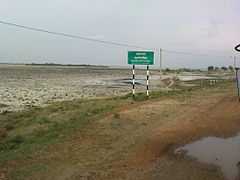Elephant Pass
| Elephant Pass | |
|---|---|
| Northern Province, Sri Lanka | |
| Type | Military base |
| Site information | |
| Controlled by | Liberation Tigers of Tamil Eelam (2000-2009) |
| Site history | |
| Built | 1952 |
| Battles/wars | First Battle of Elephant Pass Second Battle of Elephant Pass Third Battle of Elephant Pass |
Elephant Pass, (Tamil: ஆனையிறவு, Sinhala: අලිමංකඩ) Northern Province, Sri Lanka is an important military base and formerly the island's largest salt field, located in the gateway of Jaffna Peninsula. It has thus regularly been the site of battles during the civil war.
Strategic importance
Elephant Pass controls access to the Jaffna Peninsula, therefore it is referred to as the Gateway to Jaffna. It is very crucial as it is on the isthmus connecting the peninsula to the Sri Lankan mainland, as well as to territory in the Southern Jaffna peninsula. Elephant Pass connects the militarily significant town of Chavakacheri in the Jaffna peninsula to the Sri Lankan mainland.
History
Elephant Pass has been a strategic military base since 1760, when the Portuguese built a fort, which was later rebuilt and garrisoned by the Dutch in 1776[1] and later by the British. A modern military base was built there in 1952 by the Sri Lankan Army (SLA). At one time, the base and its outlying camps expanded to cover an area 23 kilometres (14 mi) long and 8 kilometres (5.0 mi) wide.[1]
Role during the Sri Lankan Civil War


The base was under SLA control until 2000, despite repeated attempts to capture it by the Liberation Tigers of Tamil Eelam (LTTE, also known as the Tamil Tigers). In the First Battle of Elephant Pass in 1991, the LTTE suffered heavy losses while trying to capture the pass. The base was used as a springboard for a number of SLA offensives during the 1990s, including Operation Yal Devi (named after the Colombo-Jaffna train) in September 1993 and Operation Sath Jaya (Truth’s Victory) in July 1996.[2]
However in a major military defeat, the Sri Lankan Army lost control of the pass to the LTTE on April 22, 2000 in the Second Battle of Elephant Pass.[2][3] The pass was finally captured by Sri Lankan force in Third Battle of Elephant Pass, as part of campaign that led to destruction of Tamil Tigers.
See also
- Place names in Sri Lanka
- Forts of Sri Lanka
- The Road from Elephant Pass(Movie)
References
- ↑ 1.0 1.1 D.B.S. JEYARAJ (May 2000). The taking of Elephant Pass 17 (10). Frontline.
- ↑ 2.0 2.1 "Tigers seize Elephant Pass". Sri Lanka Monitor. April 2000. Retrieved 2009-01-10.
- ↑ Susannah Price (2000-05-03). "Sri Lankan army on the ropes". BBC News. Retrieved 2009-01-10.